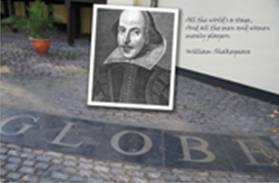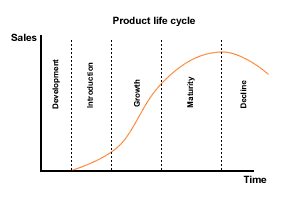Product life cycle
Seven Ages of Man
"All the world's a stage, And all the men and women merely players; They have their exits and their entrances; And one man in his time plays many parts, His acts being seven ages.
 At first the infant, Mewling and puking in the nurse's arms; And then the whining school-boy, with his satchel And shining morning face, creeping like snail Unwillingly to school.
At first the infant, Mewling and puking in the nurse's arms; And then the whining school-boy, with his satchel And shining morning face, creeping like snail Unwillingly to school.
And then the lover, Sighing like furnace, with a woeful ballad Made to his mistress' eyebrow.
Then a soldier, Full of strange oaths, and bearded like the pard, Jealous in honour, sudden and quick in quarrel, Seeking the bubble reputation Even in the cannon's mouth.
And then the justice, In fair round belly with good capon lin'd, With eyes severe and beard of formal cut, Full of wise saws and modern instances; And so he plays his part.
The sixth age shifts Into the lean and slipper'd pantaloon, With spectacles on nose and pouch on side; His youthful hose, well sav'd, a world too wide For his shrunk shank; and his big manly voice, Turning again toward childish treble, pipes And whistles in his sound.
Last scene of all, That ends this strange eventful history, Is second childishness and mere oblivion; Sans teeth, sans eyes, sans taste, sans everything."
William Shakespeare - 'As You Like It'
Marketers like to compare the life cycle of a product to that of the human life cycle. Although the analogy may lack some substance, the stages of the product life cycle do mimic that of humans. Products, like human beings, are conceived and are born. Like humans, as time passes, products move through infancy, grow and reach maturity and like humans they will eventually decline and die. Like humans death may happen suddenly at any stage. However, unlike a human, a product's life is measured in terms of its sales and there is also a possibility that a product may be reborn, which unless you believe in reincarnation will not happen to a human! In addition, the speed at which a product moves through its life cycle may vary considerably.
The stages are of this product life cycle are illustrated in the diagram below:

Figure 1 Product life cycle
This is a simple product life cycle diagram. The sales revenue line shows growth from introduction through to maturity, but declines in 'old age'. When starting the product on its life journey the firm will incur negative cash flow as money has to be invested in developing the product before launch and then more used to support it heavily in its infancy to ensure the market grows. This negative cash flow could turn into a loss if the sales revenue of the product fails to grow to cover the expended costs.
If sales grow as forecast, the cash flow should eventually become positive during the growth phase as sales revenue grows faster than costs. Once the product gains a significant market share and enters maturity the positive cash flow should increase to its maximum. How long the firm is able to maintain its product in maturity varies according to a range of external factors including competition, economic growth and social and cultural changes.
Successful firms will recognise that they will need to change their marketing strategies as a product moves through its life cycle and in the following sections we will examine some of these possible changes. However, the problem is recognising which stage the product actually is in. If the firm mistakes the stage it may make changes which endangers the product and may quicken its decline. For example, if sales begin to fall, the firm may assume that the product is moving into its decline phase and reduce marketing support. However, the fall in sales may have been caused by factors which may be temporary such as an economic recession.